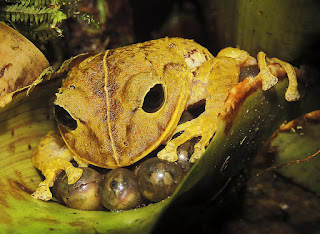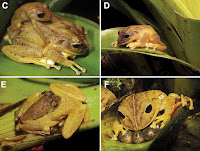 |
| Pristimantis gretathunbergae Mebert, González-Pinzón, Miranda, Griffith, Vesely, Schmid & Batista, 2022 |
Abstract
Substantial molecular and morphological character differences lead us to the description of a new species of the genus Pristimantis from the cloud forest of Cerro Chucantí, Maje Mountains, Darien Province, as well as from several other mountain ranges in eastern and central Panama. Pristimantis gretathunbergae sp. nov. is a sister species to the allopatric P. erythropleura-penelopus group from northern Colombia with a mtDNA sequence divergence of > 4.4% at 16S and > 14.6% at COI. Its closest congener in sympatry is P. cruentus that differs by a large sequence divergence of > 9.6% in 16S mtDNA and 19.0% at COI, and from which it differs also by ventral and groin coloration, unusually prominent black eyes, a contrasting light upper lip, commonly a single conical to spine-like tubercle on the upper eyelid, and a larger head. While the habitat continuity at most sites in eastern Panama is moderate, habitats in central Panama are severely fragmented. Cerro Chucantí and the surrounding Maje Mountains are highly threatened by rapid deforestation and replaced by plantations and cattle pastures. Thus, investigations on the ecology of the new species and its population status, especially at the type locality, are highly recommended. As a flagship species, this new frog can help to preserve the Chucantí cloud forest including several recently described species known only from this isolated area in eastern Panama.
Keywords: Chucantí, Craugastoridae, Greta Thunberg’s Rainfrog, Maje, Pristimantis gretathunbergae sp. nov., Strabomantidae, Terraranae
Pristimantis gretathunbergae sp. nov.
Suggested English name: Greta Thunberg’s Rainfrog
Suggested Spanish name: Rana de Greta Thunberg
Diagnosis: Pristimantis gretathunbergae sp. nov., a member of the Pristimantis ridens species group (sensu Reyes-Puig et al. 2020), is characterized by the following combination of characters: (1) dorsal skin surfaces slightly areolate, with dispersed tubercles; venter weakly areolate; discoidal fold present, dorsolateral folds absent; (2) tympanum concealed, indistinguishable or poorly distinguished; annulus and tympanic membrane barely visible in males, not visible in females; tympanic fold from the posterior edge of the eye to the arm insertion; (3) snout short, broadly rounded in dorsal view, moderate in length, rounded and slightly protruding in profile; (4) upper eyelid with a single conical to spine-like, some triangular tubercle, ED wider than IoD; cranial crests absent; (5) dentigerous processes of vomers present, prominent, oblique, each bearing from 5 to 10 teeth; (6) vocal slits and nuptial pads absent; (7) Finger I shorter than Finger II; discs on outer fingers truncate, more than twice width of digit proximal to disc; (8) fingers bearing narrow lateral fringes; (9) three to four low ulnar tubercles, barely visible in preservative; (10) heel bearing a conical tubercles, outer edge of tarsus with three to four low and small conical tubercles, inner edge of tarsus lacking tubercles; (11) inner metatarsal tubercle large and elliptical, 4–5× size of outer, ovoid metatarsal tubercle; supernumerary plantar tubercles low; subarticular tubercles conical; (12) toes bearing narrow lateral fringes; webbing absent; Toe V much longer than Toe III; discs as large as those on outer fingers; (13) dorsal ground coloration usually shades of brown with individual tones of red or yellow with or without scattered orange flecks, and/or larger reddish or distinct brown blotches, or light dorsolateral band; (14) venter uniform dirty white (some specimens exhibit dark spotting) or patternless yellow to orange; (15) groin and inner thighs white, yellow or orange-red, some with flecks matching the dorsal ground color or red; (16) blackish iris, some individuals show very dark red iris and/or red-golden speckling; (17) prominent light upper lip in all females and in some males, while other males exhibit some blotches extending from the nose vertically across the lip, however, the upper border of the light-colored lip patches is still demarcated by the darker nose coloration, except in generally light-colored specimens; (18) SVL up to 36.7 mm in males, up to 46.3 mm in females.
Etymology: The specific name is a noun in the genitive case and is a patronym in honor for Greta Thunberg, a Swedish student, and her global climate activism. Greta initiated a “School Strike for Climate Action” outside the Swedish parliament to demand a radical response to the threat by the ongoing climate change. Then sixteen-year-old Thunberg’s example has inspired students worldwide to carry out similar strikes called Fridays For Future that started in August 2018. In December 2018 she addressed world leaders at the COP24 climate talks in Katowice, Poland, with sharp and unmasked words, and equally impressed a global audience in January 2020 with her unpolitical, direct speech down to the point on “Averting a Climate Apocalypse” at the WEF (World Economic Forum) in Davos, Switzerland. Just recently, she publicly slammed the world leaders at the 26th UN Climate Change Conference of the Parties (COP26) in Glasgow, November 2021, for not doing enough to meet the demands of the climate emergency. Greta Thunberg represents the authentic voice that exposes the motivations behind the diplomatic curtain of politicians and business stakeholders. Her voice is essential if we want to revert to and maintain a healthy environment on the planet we all share, and not least, learn to respect its magnificent mega-diversity of life that took millions of years to evolve.
Konrad Mebert, Macario González-Pinzón, Madian Miranda, Edgardo Griffith, Milan Vesely, P. Lennart Schmid and Abel Batista. 2022. A New Rainfrog of the Genus Pristimantis (Anura, Brachycephaloidea) from central and eastern Panama. ZooKeys. 1081: 1-34. DOI: 10.3897/zookeys.1081.63009











